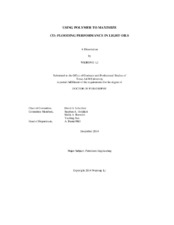| dc.description.abstract | Carbon dioxide has been used to recover oil for more than 40 years. Currently, about 43% of EOR production in U.S. is from CO2 flooding. Although CO2 flooding is a well-established EOR technique, its density and viscosity nature is a challenge for CO2 projects. Low density (0.5 to 0.8 g/cm3) causes gas to rise upward in reservoirs and bypass many lower portions of the reservoir. Low viscosity (0.02 to 0.08 cp) leads to poor volumetric sweep efficiency. In heterogeneous reservoirs with high-permeability zones and natural fractures, the condition is even worse.
Two methods related to polymers are studied to improve CO2 flooding performance. One is adding polymers to water to increase water viscosity during the water-alternating-gas (WAG) process, named polymer-alternating-gas (PAG) flooding. The other one is adding polymers with cosolvent to CO2, named CO2 viscosifier, to increase CO2 viscosity.
To analyze the feasibility of PAG, couples model considering both miscible and polymer flooding processes are built to study the performance of PAG. Polymer adsorption and concentration, reservoir permeability, permeability variation and fluid viscosity are studied. Results show that PAG process could get higher recovery than WAG if not injectivity problem occurs. The Upper Ness formation in Spe10 model is used to study the PAG performance in a reservoir with channels. Oil recovery from PAG with a polymer concentration of 0.20 lb/stb is 6% higher than WAG process in this model.
To analyze the impact of CO2 flooding in the North Burbank Unit, five sections that best represent the characteristics of the field were selected for reservoir modeling. Based on simulation results, the conventional WAG process increased average oil recovery in the North Burbank Unit by 10-13%, PAG are forecasted to increase average oil recovery 4-7% more than conventional WAG flooding in the North Burbank Unit. Based on assumptions, PAG could get positive NPV when oil price higher than $40/bbl while PAG could also obtain higher NPV than WAG in all these five sections, which indicates that PAG is both technically and economically feasible in the North Burbank unit.
A black-oil pseudo-miscible model is used for study CO2 viscosifier performance in synthetic model, SPE10 model and Section TR78 in the North Burbank Unit. Results show that higher cumulative oil recovery and better sweep efficiency was observed for viscosified CO2 case in homogeneous, heterogeneous and channels reservoirs. | en |


